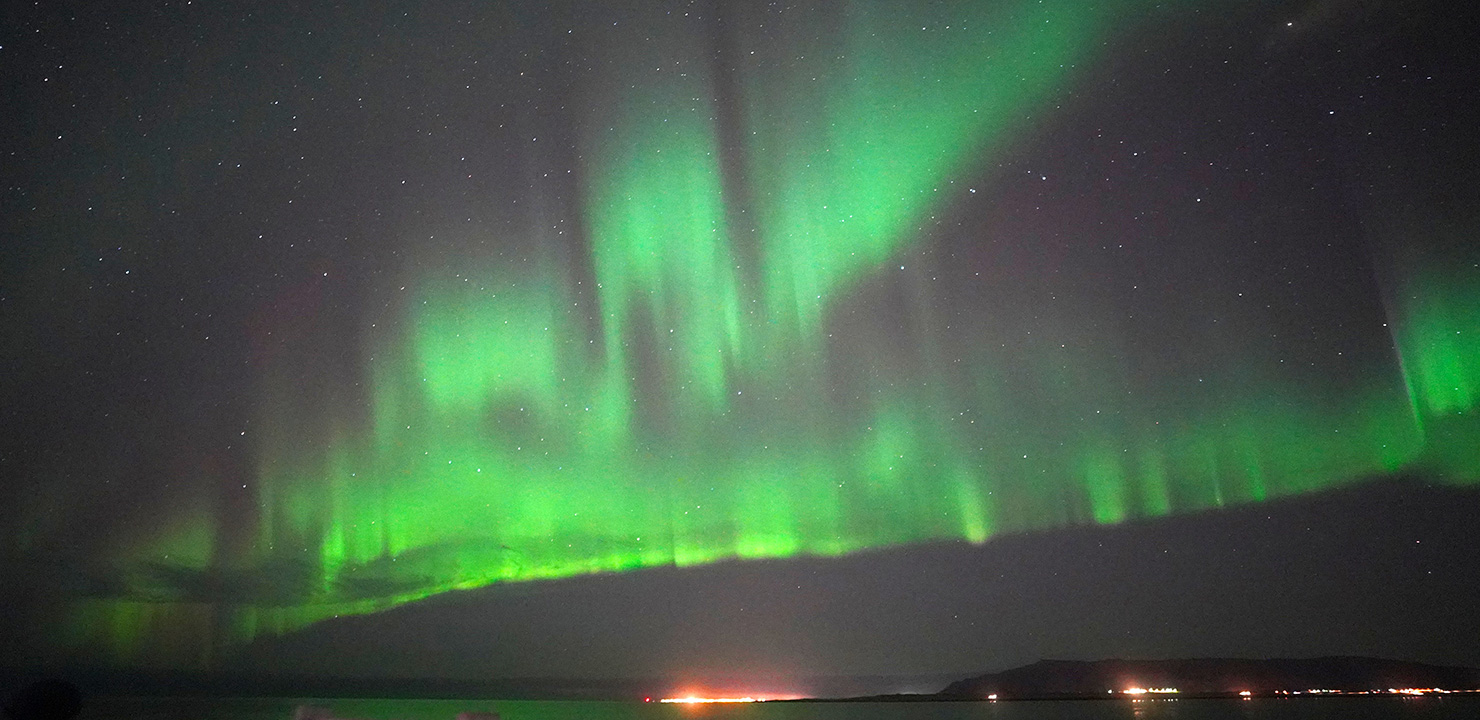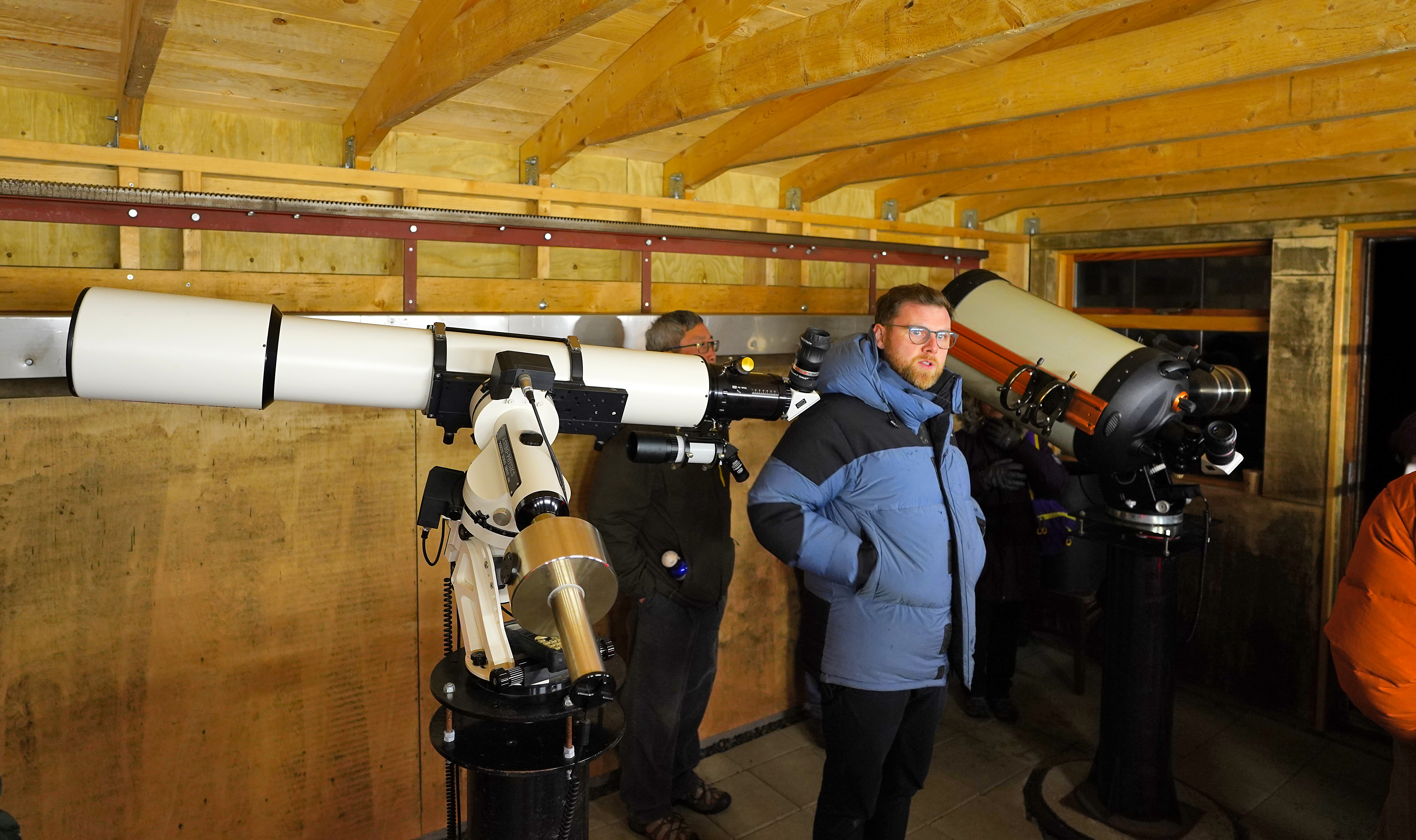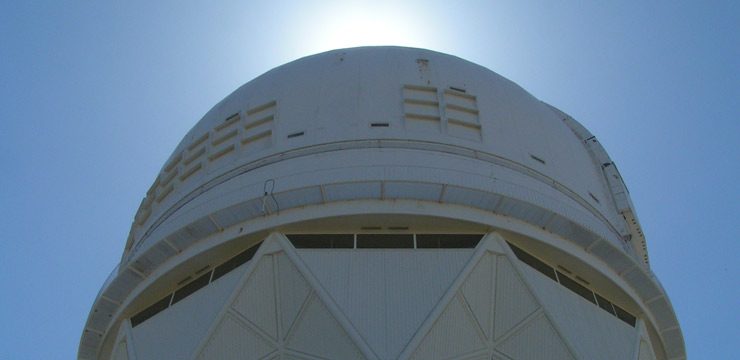
Astronomical Adventures in Iceland
February 2023 :
In October, 2022, several members of Skyscrapers, Inc., joined with members of the Rhode Island College Alumni Association on a weeklong expedition to Iceland.
Just hours after our arrival from an overnight flight from Boston, Reykjavik was to experience a 30% partial solar eclipse, at 9:30 in the morning, local time. Prepared with eclipse glasses, we went to a local cafe to start our day. When breakfast was finished, however, the sky hadn’t cleared, and we missed our opportunity to call this an eclipse trip.
Following a very long and busy first day in Reykjavik, we were scheduled to visit Hotel Rangá and Observatory, located 90 kilometers southwest of the capital city.
Although it was raining during our visit to Rangá, we were offered a presentation in the hotel’s meeting room, and a tour of the observatory by local astronomer Sævar Helgi Bragason.

The observatory contains two equatorially-mounted telescopes: a 14 inch Celestron Edge HD Schmidt-Cassegrain and a TEC 160ED APO refractor.
During the tour, we learned two interesting realities concerning astronomy in Iceland. The first is that, despite dark skies, there aren’t many observatories in the country due to the prevalence of the northern lights. It is difficult to conduct any meaningful observations, particularly with sensitive imaging equipment, when the presence of aurorae will often interfere.
The second thought-provoking revelation was when Sævar informed us that 2022 was the first time that astronomers in Iceland had been able to observe Saturn in a decade. This was due to Saturn’s position in the southernmost portion of the ecliptic, and Iceland’s location just south of the Arctic Circle, resulting in the upper culmination of the planet being only a few degrees above the horizon. During those ten years, Saturn was either too low to observe, or the sky was in twilight all night (which is what Iceland experiences from April through August) when it was at its highest. If the sky had been clear during our visit, Saturn would have been less than 10° in elevation when due south.
Although our observatory visit was rained out, we still had more opportunities to observe the night sky. Part of our tour package included an aurora-watch cruise out of Reykjavik harbor on a whale watching boat.
The first opportunity to take the cruise was clouded out, but fortunately, weather predictions for the following night were more promising. On October 26, after dinner at a harborside restaurant, we boarded the boat under cloudy skies. The boat had two decks: a lower deck was enclosed and heated, and contained the snack bar. The open upper deck had a few benches, but was mostly standing room for the fifty or so of us that gathered up there for the sky show.
We were offered coveralls, but most from our group are experienced night sky watchers and came dressed for cold weather. The temperature hovered just above freezing, and winds were calm.
Almost immediately after leaving the dock, skies began to clear, and no more than five minutes later, just as we had moved far enough from the lights of the harbor, the first hints of aurora became visible. A single faint band of green light arced low over the northern horizon. It soon split into two, then three bands, with fringes of red across the top, extending from Serpens in the northwest to Gemini in the northeast, covering much of Ursa Major.
As the cruise took us farther north, and into darker skies, the detail of the aurora became more pronounced. Slowly shimmering bands and arcs would occasionally brighten and move more dramatically. A faint green band arced overhead, approximating the position of the Milky Way, with hints of red corona directly over the zenith.
Besides the aurora itself, it was also fascinating to experience the phenomenon with several dozen excited spectators, with hushed voices of enthusiasm, and so many arms extended with mobile phone cameras snapping away so many pictures that would later be shared among the group. The on-board tour guide narrated information about the aurora, from where to look, to historic information and folklore, to the scientific explanations, then someone from our group used a laser pointer to give a constellation tour.
As the boat cruised barely faster than walking pace through the relatively still water, one of the more memorable sights was seeing the reflection of the aurora in the water.
The cruise came to an end after about two hours, and we were quite excited to have experienced one of the top highlights of the entire trip. The planetary K-index, a measure of geomagnetic storm activity, was 2.67 during the cruise. As a comparison, on the rare occasion when the aurora is visible from Rhode Island, the planetary K-index is usually 7 or greater.
During the next few days, our adventures took us to Iceland’s south, with a three-night stay at Hotel Katla, and daily excursions to surrounding attractions including waterfalls, geysers, glaciers, coastal cliffs, and museums. There were nightly opportunities, weather permitting, to travel less than an hour from town to view northern lights. Only the second of our three nights, October 28, would be favorable enough to make the expedition worthwhile.
While most in our group boarded the coach to the overlook, a few stayed and observed from the back lot of the hotel, which, while surrounded by mountains to the north, offered a relatively dark spot to observe from. The vantage point from the overlook offered a clear horizon all around, and completely dark conditions except for a small dome of light coming from the town of Vik and occasional truck traffic on the highway, over 5 kilometers to the northeast.
Weather conditions were clear and calm upon our arrival. Mars was rising low in the northeast, and several bands of bright green aurora intertwined through Auriga and Taurus, shimmered overhead, and reached towards the northwestern horizon. The northwestern position of the arc was less prominent, but occasionally flared up and became quite dynamic. Long exposure photos revealed the aurora to be bold green, but it contained little other color like we had during the cruise. The planetary K-index during our observations peaked at 4.33.
Unfortunately, within 45 minutes of our arrival, a layer of thin clouds had overtaken our observing site, but some stars and certainly the brighter bands of aurora remained visible beyond it. The clouds diffused the light from the aurora, giving an effect similar to, yet distinctly different from, when Moonlight is diffused through an overcast sky, softly illuminating the ground all around in a pale light.
We returned to Hotel Katla to prepare for another day’s excursions and another potential clear night of skywatching. After dinner on our third night at Hotel Katla, the skies were clear, but forecasts for both weather and aurora weren’t favorable enough to take another trip into the remote countryside or coastal overlook, so we enjoyed about an hour of clear, but windy, conditions from the hotel back lot. A hint of auroral activity was present just over the mountain, but could only be detected photographically.
All too soon our expedition to the “land of fire and ice” came to an end, and we came home fulfilled with the satisfaction of having experienced a beautiful subarctic country with its stunning natural wonders, friendly and fascinating history and culture, incredible cuisine, and of course, celestial wonders rarely experienced for dwellers in the temperate zone.
Aurora borealis stretches across the northern sky as seen from on board the Andrea tour boat sailing north of Reykjavik harbor.
Related Topics




